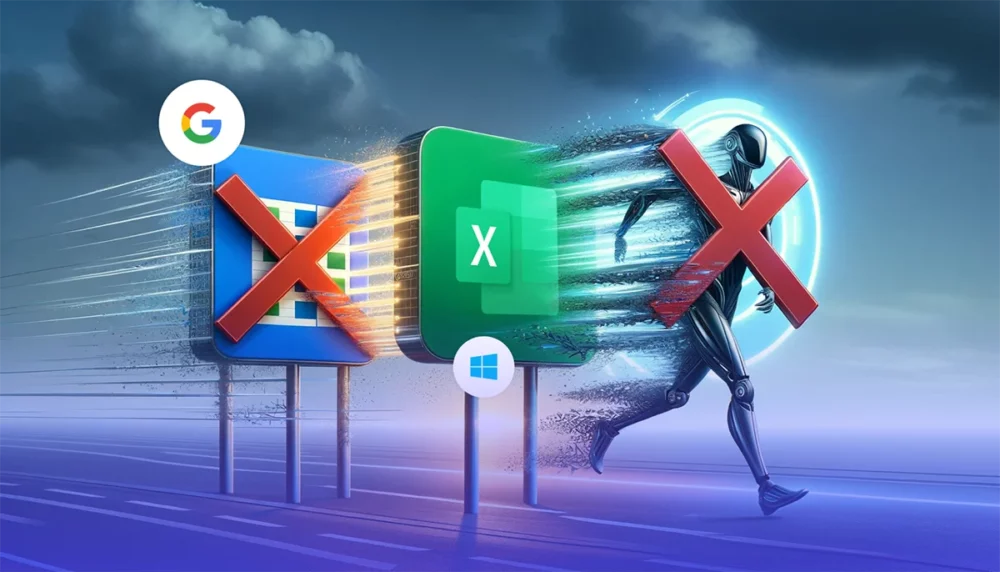Excel, Google Sheets or Sloneek? What is the best for your HR?

Was one of your New Year’s resolutions to finally set up a system in your HR agenda? Definitely a good idea! But what to do with all the data you need to store and use easily at the same time? Modern tools like Microsoft Excel, Google Sheets, and Google Workspace are often the go-to for storing and reviewing employee data.
Your choice- like 95% of your colleagues would do- will probably be the most affordable solution: Excel or Google Sheets. That is, a spreadsheet that may seem to be good idea at first sight.
Let’s see how they actually hold against a dedicated HRIS such as Sloneek.
Why Choose Excel or Other Spreadsheets?
At first, a question. Why do HR people like Excel and similar tools so much? The answer isn’t surprising- they know it, just like the management of their companies or their employees. It’s installed on the vast majority of the computers. It is- at least at first glance- free. And the data can be easily sent or processed on your computer at home, for example if you need to catch up on something. Especially in smaller companies, Excel spreadsheets or a Google account are already in daily use for personal use or employee databases, making the switch feel effortless.
Moreover, the fact that most people know how to use it makes it possible to start working with it right away and saves a lot of time. But there’s the question – really?
Why does it seem to be easy at first sight?
| Excel / Google Sheets | Sloneek | |
| Already on my computer | ✅ | 🚫 |
| No need to consult it/ raise money for it | ✅ | 🚫 |
| Colleagues and management can use it | ✅ | 🚫 |
Many users also rely on tools like Excel templates, revision history, and Excel workbooks to track changes and structure their HR documentation.
Why is reality different in the end?
| Excel / Google Sheets | Sloneek | |
| I spend time creating my own system and testing it | 😓 | 😊 |
| There are mistakes I have to deal with | 😓 | 😊 |
| I hit the limits I didn‘t count on at first | 😓 | 😊 |
| I‘m in charge of know-how on the system and have to explain it to my colleagues | 😓 | 😊 |
| Anyone who interferes with the system, can cause it to stop working | 😓 | 😊 |
Excel and Google Sheets vs. Sloneek HR System Comparison
Basic requirements comparison
Many companies just shrug potential risks off and start using their HR system built on sophisticated spreadsheets in practice. However, will it meet the basic requirements of HRIS?
Easy to use
Above all, HRIS must be simple. Simple enough that even untrained employee can work with it if necessary. Let’s compare Excel, Google Sheets and Sloneek.
Functions like cell reference, pivot tables, or smart chips may offer some level of organization but require more expertise than initially expected.
| Excel / Google Sheets | Sloneek | |
| The basics can be explained to colleagues during one meeting | ✅ | ✅ |
| If I don‘t know how to do it, I can ask anytime | 🚫 | ✅ |
| Intuitive at first sight | ❓ | ✅ |
| Possible to use it without training | ❓ | ✅ |
Data security
HRIS usually stores the most sensitive information about your people. That’s why GDPR representatives consider it to be one of the most important places where security incidents may occur. How do Excel, Google Sheets and Sloneek face them?
Also, tools like Google Drive, Microsoft 365, or Office 365 lack centralized HR dashboard functionality unless extended via third-party services or Google APIs.
| Excel / Google Sheets | Sloneek | |
| GDPR compliant at the core | 🚫 | ✅ |
| Login security | 🚫 | ✅ |
| Management of access rights to data | 🚫 | ✅ |
| Difficulty in copying data | 🚫 | ✅ |
| Easy audit | 🚫 | ✅ |
All data in one place
A setback for effectivity? Data in different places and in different versions or dates. If the HR department wants to get rid of the circles under their eyes, they need to keep strictly just one up-to-date database that the entire company works with. How does Excel, Google Sheets and Sloneek handle this?
Fragmented use of Google Docs, Google Slides, and Google Calendar can cause confusion due to inconsistent version history or outdated files.
| Excel / Google Sheets | Sloneek | |
| Data strictly in one place- no multiple versions | 🚫 | ✅ |
| Data always available anywhere | 🚫 | ✅ |
| Data cannot be simply rewritten or copied | 🚫 | ✅ |
Sharing information
What is the most common reason for HR department overwork? That they have exclusive access to some information even though the others could normally work with them. They have to answer trivial questions and send simple information to dozens of people monthly. How can Excel, Google Sheets and Sloneek help with this?
While file sharing in Google Sheets or Excel online is possible, managing employee satisfaction scores, employee engagement surveys, or Employee Appraisals across multiple spreadsheets often leads to errors and miscommunication.
| Excel / Google Sheets | Sloneek | |
| Everyone can access the files based on his access rights | ✅ | ✅ |
| Information can be easily sorted by access rights | 🚫 | ✅ |
| Employees can see and change the data that belong to them | 🚫 | ✅ |
Price
How much is it? Price is of course a key parameter. The irony is that the system is often chosen based on it. However, hidden costs can arise when integrating Power BI, KPI dashboards, or automated data analysis tools with MS Excel or Google Looker Studio. How about the costs of the system in Excel, Google Sheets and Sloneek?
| Excel / Google Sheets | Sloneek | |
| Payments over and above the salary of HR staff | 🚫 | ✅ |
| Payment for real users in a given month | 🚫 | ✅ |
| Paying for development over time at the expense of other things | ✅ | 🚫 |
| I know in advance how much it will cost to develop the system in a year | 🚫 | ✅ |
Excel vs. HR System: Comparison of Specialized Requirements
It’s absolutely crucial that the chosen HR system can’t fail in the main thing- the ability to work with data efficiently and without time loss. If it’s meant to be a real help, it must do much more than just store information about personal data of employees, their salaries or leave entitlement.
Let’s take a look at how Excel or Google Sheets handle specialized tasks and how Sloneek handles them.
| Excel / Google Sheets | Sloneek | |
| Accumulated leave | ✅
Information about drawing must be regularly recorded by the system administrator |
✅
Information is automatically rewritten based on approved requests |
| Request for leave | 🚫 It can store leave information but it often has to be entered directly by HR person |
✅
It allows you to check in a leave request and work with it across the system. It’s visible to everyone for whom it’s relevant. |
| Up-to-date data relevant to salaries | ✅
Information must be updated regularly by the system administrator |
✅
Information can be updated directly by the user |
| Electronic signature of documents | 🚫 | ✅ |
| Questionnaire survey | 🟡
Partially solvable using Forms |
✅
Possible to implement directly in the system |
| Contracts and certificates | 🚫 | ✅
Possible to save directly in the system |
| Timetracking | 🚫 | ✅
Possible to use directly in the system |
| Connection to other applications via API | 🚫 | ✅
Possible to use guaranteed directly in the system |
| Recruitment | 🟡
Partially solvable |
✅
Possible to use specific detailed functions in the system |
| Onboarding and offboarding | 🟡
Partially solvable but mostly as a tool for HR |
✅
Possible to use specific detailed functions in the system with employee involvement |
Advanced functions
The HR professional’s agenda is already quite busy. It makes sense that tools that can streamline and automate his work are really appreciated in this field. How does Excel or Google Sheets help in this regard and how does Sloneek?
In Excel, features like Visual Basic for Applications, macro programming language, and Power Pivot exist, but are rarely used in HR context without advanced training or dedicated IT support.
| Excel / Google Sheets | Sloneek | |
| Automation | 🟡
Partially |
✅ |
| Delegation of simple tasks to teamleaders or employees | 🚫 | ✅ |
| Basic data visualisation | ✅ | ✅ |
| Running analysis and graphs in one place | 🟡
Partially |
✅ |
| AI involvement | 🚫 | ✅ |
Evaluation: Excel vs. Sloneek HR System
Excel and Google Sheets will likely remain the number one choice for HR managers who don’t yet have deep experience with HRIS for a few more years. The reasons for taking the first step are clear – a quick start, low costs, and high comprehensibility. But that’s usually where the list of benefits ends.
As soon as spreadsheets stop serving as a centrally managed database accessible only to a small group of trained staff and start aiming to become a fully-fledged HR system, they hit a wall.
The costs of developing such a solution will be significantly higher than initial estimates, while its security, functionality and overall benefits will be lower – even with integrations like Google Workspace APIs or Excel Object Model, which require technical knowledge to configure.
| Excel / Google Sheets | Sloneek | |
| Long-term solution reliability | ⭐ | ⭐⭐⭐⭐⭐ |
| Ability to grow with the company | ⭐ | ⭐⭐⭐⭐⭐ |
| Ability to add new functions | ⭐ | ⭐⭐⭐⭐⭐ |
| Universality for the entire company | ⭐⭐ | ⭐⭐⭐⭐⭐ |
| Compatibility with other tools | ⭐ | ⭐⭐⭐⭐⭐ |
| Handover limit | ⭐ | ⭐⭐⭐⭐⭐ |
| Solution security | ⭐ | ⭐⭐⭐⭐⭐ |
| Time- consuming to manage | ⭐⭐ | ⭐⭐⭐⭐⭐ |
| Total cost including time cost | ⭐⭐⭐ | ⭐⭐⭐⭐⭐ |




